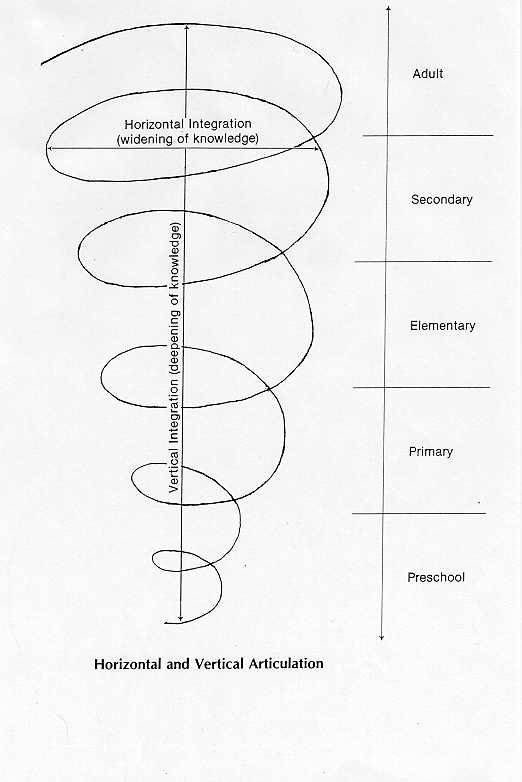- Structure is an essential characteristic. The curriculum is
structured by
- Sequence (what topic follows another in time)
- Hierarchical relationships between various content elements.
- Learning outcomes usually come from three sources:
- Knowledge (e.g., facts, concepts, generalizations)
- Skills (e.g., processes, techniques, abilities)
- Values (e.g., the affect, viewpoint, attitude)
Three sources of curriculum are the:
- Needs and Interests of Learners (focus on individual -- choice of
material based on individual needs, interests, abilities) [Rousseau]
- Values and Problems of Society (focus on the people interacting with
each other often looking to the future) [See for example, SCANS
Workshop Skills - SCANS stands for Secretary's Commission on Achieving Necessary Skills, U.S. Dept. of Labor]
- Realm of Organized Knowledge or Subject Matter (belief that there is a
common knowledge foundation that every student must acquire) [Disciplinary view]
A balance among these three sources is important.
Three general principles of curriculum formation are:
- Keep the students up front in the planning process. These means
taking into account concerns about:
- Quality -- promotion of student development intellectually,
psychologically, physically and socially
- Equality -- quality experiences for all students
- Personalization -- assignment and allocation of programs to the
specific set of individual differences represented in the student body
- Relevancy -- appropriate to the needs of the student, society, and
school purposes.
The organization of the curriculum should foster coordination and
collaboration among teachers and media specialists to allow unified
learning across specialization and grade level
- The school day should be balanced with a variety of learning
experiences and a variety of teaching activities (e.g., balance between
quiet and intense activities)
Several curriculum design patterns can be identified although few operate
in pure form. Most draw elements from several designs and fuse them into
a plan for a particular situation. Common organizing elements for all
curriculum designs include:
- Determination of what is important following a study of the learners
for whom plan is devised, the societal requirements and goals, and the
knowledge required to fulfill these needs and goals. This establishes the
context for the curriculum.
- Broad goals are formulated followed by more specific objectives.
Required skills, understanding, attitudes and affects, and abilities are
then determined.
- Appropriate learning experiences are designed and systematized into a
logical and hierarchical pattern.
- Evaluation procedures and techniques are determined for both
student progress and curriculum validity.
Six curriculum design patterns will be examined, as follows:
- The Subject-Centered Design
- The Broad Fields Design
- Social Processes and Life Functions Design
- The Activities and Experiences Design
- The Core Curriculum Design
- The Process-Oriented Curriculum Design
Remember, there are few pure forms but most schools favor certain
approaches more than others. Each of these design patterns will be
considered below with a definition and diagram and a comment about
the impact of the pattern on the school library media center.
The Subject-Centered Design. The origins of these go back to the
Trivium and Quadrivium of classical times (the seven Liberal Arts). Each
subject is separated. Mastery of the subject matter is the central task.
Standards are set for the amount of subject matter covered and for learner mastery
of content. Learning sequences are usually in a step-by-step pattern. A
textbook is the primary instructional tool. The breadth of the
subject-centered curriculum is determined by the number of subjects taught.
Each subject has three characteristics:
- a unique body of content
- its own intellectual discipline (e.g., scientific method, historical
method, etc.)
- its own pattern for organizing the content.
Objectives are derived from the important generalizations found in the
field of study and the intellectual processes inherent in that field. The
library is used primarily in content-oriented ways with a focus on
selection and use of specific materials in a single content area.
Interrelations between various subjects are not stressed. Questions focus
on "what" rather than "how" or "why."
A diagram of this design is as follows:
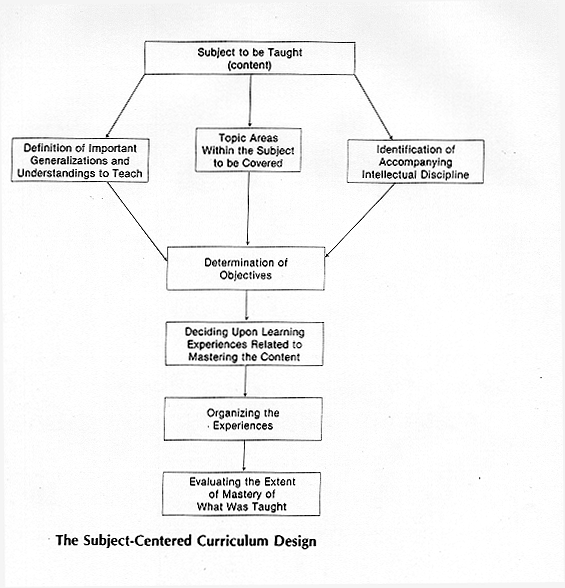
The Broad Fields Curriculum Design. The broad fields design
combines two or more related subjects into a single broad field of study,
for example, Language Arts combines the separate but related subjects of
Reading, Spelling, Writing, Speaking, Listening, and Composition. The
Broad Fields, commonly found in elementary and middle grades, is an
attempt to overcome the fragmentation and compartmentalization
characteristic of the subject-centered design. The intent is to achieve a
greater integration of learning experiences.
Use of the broad fields design cuts down on the amount of factual detail
often found in subject-centered designs but still allows little
integration between the broad fields themselves. The design stresses
content coverage and acquisition of information. The school library will
be used more extensively than in the subject-centered design and can
help reinforce the interrelationships among the subject areas within a
broad field of study.
A diagram of this design follows:
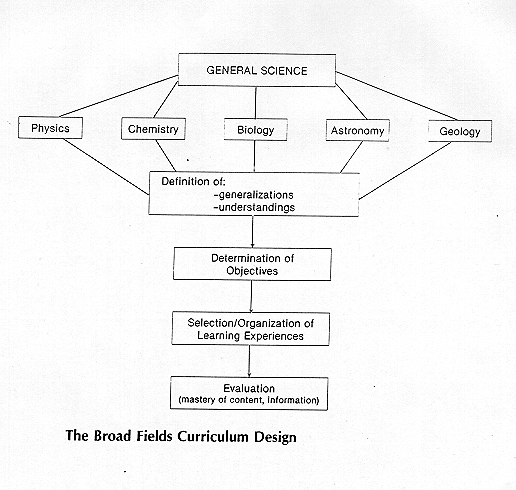
Social Processes and Life Functions Design. This design is focused
heavily on society. Social processes, functions, or problems become the
center for the design of the curriculum. One way to look at this approach
is to see it as using social studies to become the general background of
the entire curriculum. A major goal is the improvement of society through
the direct involvement of the schools.
The curriculum is structured around the various aspects of problems and
processes of community life with the subject areas subservient to the
problem. Careful development of continuous themes for the entire
curriculum is important. This design is more subjective than is either
the subject-centered or broad fields. Cooperative planning occurs more
frequently. The curriculum is more flexible. Skills taught are skills
students can apply to everyday living. Many resources and materials are
used in addition to, or in place of, the traditional textbook. The library
media center is used extensively to work out solutions to social problems
by drawing from many sources.
The validity of this approach may be questioned by parents and others.
The diagram below shows some examples of "content" elements that might be
included: communication, transportation of goods and people, freedom of
the individual, exploration, production of goods and services,
distribution of returns of production, education, aesthetics, recreation,
protection and conservation of life, property and natural resources. All
elements are interrelated and collectively known as social processes and
problems of living.
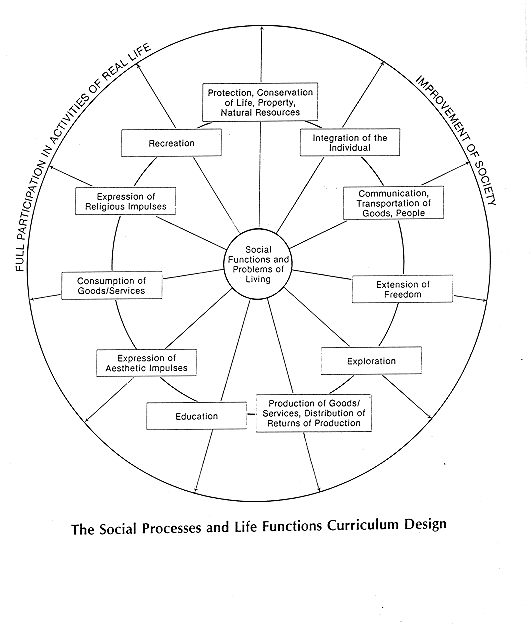
The Activities and Experiences Curriculum Design. This design
focuses on student interests and the integration of content from any
subject field. This approach might be considered more a teaching method
than a curriculum design because it can be used in conjunction with
several other design models. The emphasis is on learning as an active,
dynamic process. Learners are encouraged to use problem-solving skills
and methods and to set their own tasks. Subject matter is drawn upon as
needed for a particular task. Specific skills and knowledge are acquired
on an as-needed basis.
The needs and interests of the learners determine what will be studied.
Thus, one often sees this design in private schools or in alternative
schools where students have had difficulties adjusting to a more
structured classroom. The school library has be heavily used in this
design and can become the major vehicle for "delivery" of the
curriculum.
The major disadvantage of this design is that it is difficult
to build a systematic system of knowledge. In practice, efforts to
take this kind of
information into consideration for any type of curriculum planning are
encouraged. The diagram below shows how the learner's needs and interests
drives the curriculum. The dotted lines connecting subjects and skills
suggest that learning in these areas may not receive consistent attention.

Core Curriculum Design. This design focuses on the set of learning
experiences that are felt to be essential for all students. Its
underlying purpose is to create a universal sense of inquiry, discourse,
and understanding among learners of different backgrounds and aspirations.
Broad areas of concern are examined and set of learning experiences
intended to promote a common body of knowledge are carefully prepared.
We use such an approach in SILS as do most professional schools
In K-12 schools, a general education is the goal of the core curriculum.
Integration and unfification of learning is stressed and accomplished by
the systematic correlation of subject matter around themes drawn from the
contemporary problems of living. Problem solving through reflective
thinking is encouraged. Examples of possible themes include: civic
responsibility, an understanding of economic systems and how people
relate to one another within these systems, family relationships,
informed consumerism, development of aesthetic appreciations, proficiency
in spoken and written language. The school library
media center can be an essential component in providing the wide variety
of learning experiences expected in the core curriculum design.
Subject matter lines are cut across
and
attention given to the needs of the learner. Learner respect for one
another is promoted. Learners have the opportunity to test their own
values and ideas. Cooperative teacher-student planning is emphasized and
learners are grouped homogeneously. A wide range of ability levels can be
accommodated because the problems being investigated are considered to be
universally significant.
The diagram below shows the philosophical orientation and doesn't show the
specific subject matter or themes within the core. The different groups
of learners are shown as they enter the core. Upon completion of the
core, learners of diverse background are able to interact with one another
based on a set of shared understandings and a sense of shared
responsibility.
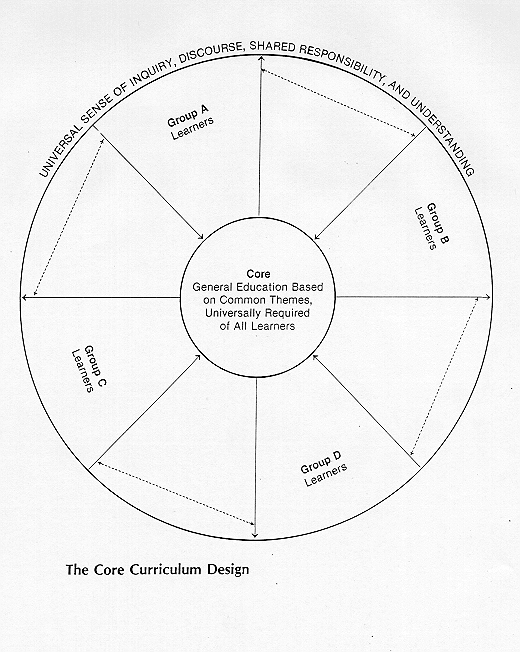
The Process-Oriented Curriculum Design. This design focuses on
personal attributes and skills of the individual learner. These may
include such aspects as: working well with others, effective leadership,
knowing how to take and follow directions, communicating effectively,
making accurate observations, learning independently, making decisions,
making good judgments, inventing, forecasting, planning, monitoring the
effects of one's own activities, taking correction action when necessary,
creating, initiating, developing a sound value system, having
self-confidence, being sensitive to others.
The development of skills and traits that will serve the learner for a
lifetime characterize this design. There is a higher degree of carry-over
into everyday living experiences than in other designs, and a better
balance between affective and cognitive considerations. The library media
center can provide materials, resources and services promoting independent
learning and creativity.
This curriculum design suffers from a difficulty in assessing learning
outcomes due to subjective judgments. Parents may be skeptical. The
diagram below shows how the learner transfers these process-oriented
skills in ever-widening circles from himself, to his schooling, to life as
a productive member of society.

Horizontal and vertical organization are two necessary dimensions of any
curriculum design. Vertical organization (sequence, continuity) deals
with the longitudinal arrangement of the design components. Horizontal
organization (scope, integration) deals with the side-by-side arrangement
of the components in the curriculum design.
A spiral concept of the curriculum provides for both horizontal (widening
of knowledge) and vertical (deepening of knowledge) aspects of the
curriculum design simultaneously. The figure below shows the concept of
horizontal and vertical articulation from preschool to adult.
